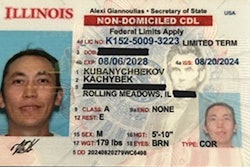Following the Trump administration's executive order to increase English Language Proficiency (ELP) enforcement for truck drivers, University of Tennessee professor Alex Scott analyzed federal roadside inspection data from May to September 2025 to connect any dots between ELP violators and other safety hazards.
His research found that enforcement was non-uniform, with states like Texas and Wyoming actively citing violations while California virtually ignored the mandate. Second, he noted a strong correlation exists between ELP violations and other safety issues.
Contents of this video
00:00 10-44 intro
00:18 English-language proficiency regulations
01:03 Why the ELP executive order sparked this trucking safety research
02:16 ELP violations and the link to other safety issues
03:03 ELP enforcement
05:29 How ELP violations correlate with more violations
06:38 English-language violations and safety scores
08:04 Summary of findings: The ELP-safety correlation
Speaker 1:
CCJs 10 44 is brought to you by Chevron Delo, heavy duty diesel engine oil. Now there's even more reasons to choose Delo
Speaker 2:
With English language proficiency. Regulations now being more widely enforced are fleets with ELP violations any more unsafe than fleets without.
Speaker 1:
Hey everybody, welcome back. I'm Jason Cannon and my co-host is Matt Cole. There might not be a bigger story in trucking in 2025 than English language proficiency requirements for truck drivers and how the Trump administration's immigration crackdown is impacting trucking with President Trump's April executive order requiring ELP enforcement and the regulations return to the out of service criteria. Data has started to emerge about how English language violations relate to other violations.
Speaker 2:
A new research paper from University of Tennessee, professor Alex Scott, takes a look at federal data on trucking violations and motor carriers CSA scores to examine whether drivers and carriers with ELP violations are any more unsafe than those without.
Speaker 3:
I've been in around the trucking industry for over 20 years. My first real job I would call it was with JB Hunt Transport large trucking company, and that's really when I fell in love with the industry. So I've worked in transportation, logistics and consulting for about 10 years, and then after 10 years I went into academia and got a PhD and I've been a professor at a few places and I'm currently at the University of Tennessee and I kind of came back to where I started all my research for I guess 12 plus years has been on trucking. And I generally like to look at safety. I look at regulations and public policy, sustainability, these kinds of issues is what my research focuses on. So this was a big order put out by President Trump. It's not that often that presidents put executive orders specifically on the trucking industry. So that kind of inherently makes it interesting. It brings a natural question as to whether the carriers and the drivers that are failing, these are getting violations for English language efficiency, whether they would be having worse inspections in general or what kind of carriers they're working for, what kind of safety profiles of those carriers. So it was really kind of just a hot topic and I thought it was interesting, general, honest, intellectual interest in it. That was kind of what drew me to it.
Speaker 1:
When Alex began to see the uptick in ELP violations over summer, he started looking at how drivers and carriers with those violations during an inspection compared to industry averages when it comes to other violations,
Speaker 3:
Which just started off well, if we have these violations in inspection, are these trucks and are these drivers also more likely to have other violations compared to your average truck driver? Right? So we're talking about our service violations, unsafe driving violations, vehicle compliance, these kinds of things. So how do they relate to your average truck inspection? Are they worse or is it just everything else is the same? It's just they happen to have these English language violations. And then the next question is, well, what do the carriers look like? The safety profiles of the carriers they work for? Those are the goals of the research. Very straightforward questions
Speaker 2:
To conduct his research. Alex looked at roadside inspection data from the time the executive order went into effect around May 1st through late September. The first part of the research looks at ELP enforcement itself. How did enforcement change after the executive order was signed?
Speaker 3:
First of all, looking at the enforcement of it was actually really quite interesting because it's not uniform. First of all, you see a ramp up. So as ordered in May, of course you're not going to see immediate enforcement. So it took a month or a couple months to kind of get ramped up and inspector started enforcing this and then you surely they had to figure out how they were going to enforce this and what kind of tests they were going to do. But so you see a ramp up in June and July and then you see it kind of steady out through September, which is when my data runs through. Now, it was highly non-uniform as to where these violations were found, and you can infer enforced based on where they're finding these inspections. Federal inspectors found by far the largest percentage of violations and you also saw Wyoming and Texas and Arizona were the next three, I believe.
And then where was it not enforced? California was practically not enforcing it at all. The percentage of English language violations and inspection was 0.005%. In California, you can compare that to something like five or 4% for Wyoming or Texas. So the reach difference is so massive. And actually what I found even most striking is if you took January to May and then May to September, California found more violations before the enforcement went into effect. And so they found more violations from January to May than from May to September, which tells you they're clearly ignoring the executive order.
Speaker 1:
The next part of Alex's research looked at roadside inspection violation data comparing the number of non ELP violations for inspections with an ELP violation to inspections without an ELP violation. We'll take a look at that after a quick word from 10 44 sponsor Chevron lubricants.
Speaker 4:
We serve customers from Birmingham, Alabama to the Gulf Coast, so our people and our trucks are booked solid all day. There is no slack in our schedules. These trucks can't break down. I choose an engine oil that takes care of the number one issue with our engines emissions, so we don't have to worry about DPF clogging. I choose the engine oil that keeps our trucks hauling. I choose DELO 600 a DF in.
Speaker 3:
What I did is I took an inspection and you have violations and inspection or a clean inspection, you can have a clean inspection. And then I took the violations that are the English language violations and tossed them out because we don't want to count those. Let's toss. Those are just indicators of an inspection with an LP. So then I compared the total violations rates in these two groups. So inspections with English language violations, but I'm tossing those violations out when I'm counting. And then a comparison group of those without English language violations. So let's look at the total violations and you find is the inspections with English language violations have a lot more other violations than the inspections without those ELP violations. And it's quite substantial. It's substantial in total violations. It's substantial in driver violations. It's substantial on out of service violations, driver out service violations, vehicle out service violations. Across the board, you find substantially more violations per inspection for the inspections that have ELP violations versus the inspections that do not have ELP violations. And it's not really very close. You don't even need to run statistic. I do a lot of statistics in my work. You don't even need to really run 'em. Just look at summary numbers. And the story's pretty clear.
Speaker 2:
The story for the safety ratings of carriers that had ELP violations was largely the same as that for inspections. Those with English language violations had on average were safety scores than carriers without those violations.
Speaker 3:
So that's previous I'm looking at. So now I'm looking at safety scores of the overall carriers, right? So a driver is an inspection. Inspection then is tied to a carrier and the carrier could have one truck or 500 trucks. And so now I then have F-M-C-S-A basic scores. So the basic categories, you have seven categories. I looked at unsafe driving our service compliance and vehicle maintenance basic categories. And so those are monthly numbers that I have going back to 2017. So I looked at those scores for the carriers in the inspections with the different types of violations. And what you find is that the carriers with ELP violations have substantially worse safety scores for those three categories. Our service, unsafe driving and vehicle maintenance than carriers that do not have ELP violations. And it's quite stark in some cases. I have it all in the paper. And by the way, the paper is available for free and it's written very clearly for anybody to consume. And so the numbers are in there, but they're quite stark in terms of how bad those average scores are for a lot of carriers that have these ELP violations. So it indicates that carriers with worse safety scores and worse safety performance as defined by the F-M-C-S-A are hiring and employing the drivers with the ELP violations versus not.
Speaker 1:
Alex concluded his report noting that there is definitely a correlation between English language proficiency and higher violation rates and worse safety scores. What he didn't determine, however, is if there's any causation between the two,
Speaker 3:
A couple different things. One is that the ELP violations are associated with unsafe carriers and you could say unsafe drivers if they're drivers that have more in violations per inspection. So if you want to call that an unsafe driver, then you could say they're affiliated with unsafe drivers and unsafe carriers. Now, exactly. Why is that? I can't really go into why. So I'm not saying ELP, the lack of speaking English makes you a worse driver. I'm not saying that. It's not like this causes, I don't know that the causality here, but all we can say is that they are related and it's quite clear. And what I think you probably have is maybe carriers with, this is a guess a speculation on my part, but I would guess that carriers with unscrupulous safety management practices, it could be that they're taking advantage of employees that can't speak English, right? Maybe they're finding employees that can't speak English and taking advantage of 'em that they don't know any better. I mean, that's possible. So there's a lot that could be done further from this research, but it does show very clearly that English language ELP violations are associated with unsafe driving and carriers.
Speaker 1:
That's it for this week's 10 44. You can read more on ccj digital.com. While you're there, sign up for our newsletter and stay up to date on the latest and trucking industry news and trends. If you have any questions or feedback, please let us know in the comments below. Don't forget to subscribe and hit the bell for notifications so you can catch us again next week.











